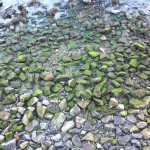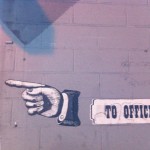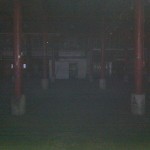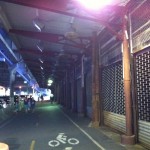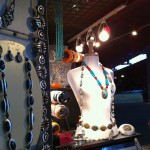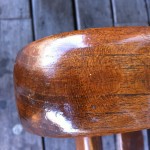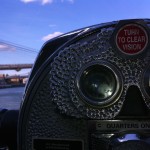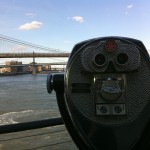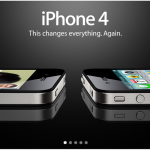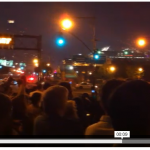Steve Jobs touted quite a bit about the new camera and sensor in the Apple iPhone 4. For starters, it is 5MP and is a back-illuminated CMOS sensor. Theoretically, it should be able to take some very stunning and wonderful pictures. Jobs even compared the iPhone itself to being beautiful and like an old Leica camera. Is it? To test this out, I borrowed my friend Devindra Hardawar and his iPhone as we strolled along South St Seaport to see just how well it performs.
Update: Technical data on the camera has been discovered.
Ergonomics
In use and as a phone, the iPhone is wonderful—minus that stupid antennae problem. As a camera, not so much. For starters, it seems like you’re shooting with a piece of glass. Thin cameras are nice, but when they’re too thin there is a problem. Think twice about using your iPhone as your primary camera. The ergonomic layout of it doesn’t allow users to grip it in a way that allows the photographer to take the best pictures possible.
One major reason for this is the fact that one needs to press the button on the touchscreen to take a photo. With the buttons on the side of the iPhone, I don’t understand why one of these couldn’t be programmed to take the pictures instead.
And if Jobs says that I’m holding it wrong…
Autofocus
The autofocus is actually very, very good. It focuses exactly where you would want it to and it seems to also have facial recognition which works even better for the types of things that iPhone users would shoot. Despite this, it is a bit slow to focus but it will focus. The tap to focus feature is very useful and works well enough for most people that know how to use their iPhone.
The autofocus seems to work very well even when the shooter is in low-light situations. Devindra and I tested this out in some of the darker and shadowy areas around Seaport. Part of this is once again, the very good tap to focus feature. It works very well in areas that most other point-and-shoots will struggle.
The even better feature is that if your subject is moving, the iPhone 4’s autofocus will track the subject as it moves. This is great for when your friends are mildly intoxicated or even when you are. From this test, it can also be concluded that being jittery after drinking lots of coffee will not effect your focusing very much unless the focusing is being slow.
On top of all this, the focusing point is also the point where the camera chooses its metering. Check out some results below.


Image Stabilization
This was my main peeve with the camera. Apple got the focusing right—but what is it without image stabilization? There is no image stabilization whatsoever in the iPhone 4. Not even digital! That perplexed me; Apple said how great the camera is. For the most part, they’re right about that for a phone camera but then Apple went and didn’t include something that is so important to taking pictures these days.
Even my T-Mobile G1 (the first Android phone) has image stabilization.

Users with shaky hands, like myself, will probably not be very happy with this problem. To be fair, users with lower standards of image capturing might be fine with it, i.e. those who aren’t professional photographers. If you have shaky hands, then don’t run up to the birds trying to take their pictures because your breathing rate will have increased quite a bit and will make you shaky. If you have steady hands, then you should be fine.
No testing involving the use of alcoholic beverages was conducted during this testing.
No, wait. That’s a lie. Devindra and I did have a drink with dinner. But they didn’t effect us. The drinks were right before the High ISO testing.
Image Quality
Image quality from this phone is very good in good lighting. In fact, it isn’t even half bad in low-lighting. With only 5MP though, don’t expect to make heavy crops. The best thing to do is to use the iPhone like it is a camera with a prime lens (or fixed focal length) on it.

Don’t even mention the digital zoom. Like other cameras, it is still best to use optical zoom. I did try it on the iPhone 4 and wasn’t very pleased with the results. To be honest, the photos look excellent on the iPhone 4’s gorgeous display. Put them on a computer though, and you’ll begin to think otherwise.
The image quality will be good enough for most people that don’t crave for the greatest amount of detail or highest quality pixels in the world. The only major flaw to it is the lack of image stabilization.
HD Video

The video that the still was taken from (and can be seen here) was taken by Devindra himself during the 4th of July. For a phone, this is very solid performance. The iPhone 4 shoots 720p HD video and to be doing it at night like this is very good. I can’t even see much of a jello effect from the video.
High ISO Images
For a back-illuminated sensor, the iPhone’s high ISO results are actually pretty decent. The noise levels can be dealt with in Lightroom or Photoshop pretty easily. The sensor isn’t all bad though. If it was able to shoot RAW images, this would be a major deal.
The problem is that the images won’t always look so great when converted to black and white because of the banding and chromatic noise.
Here are some samples.


Flash Usage
This is where the iPhone 4’s game is weak. The flash on the camera just isn’t that powerful at all. It seems to truthfully be nothing more than someone taking a keychain flashlight and illuminating their subject.


Gallery
Please Support the Phoblographer
We love to bring you guys the latest and greatest news and gear related stuff. However, we can’t keep doing that unless we have your continued support. If you would like to purchase any of the items mentioned, please do so by clicking our link and then purchasing the items as we then get a small portion of the sale to help run the website.








